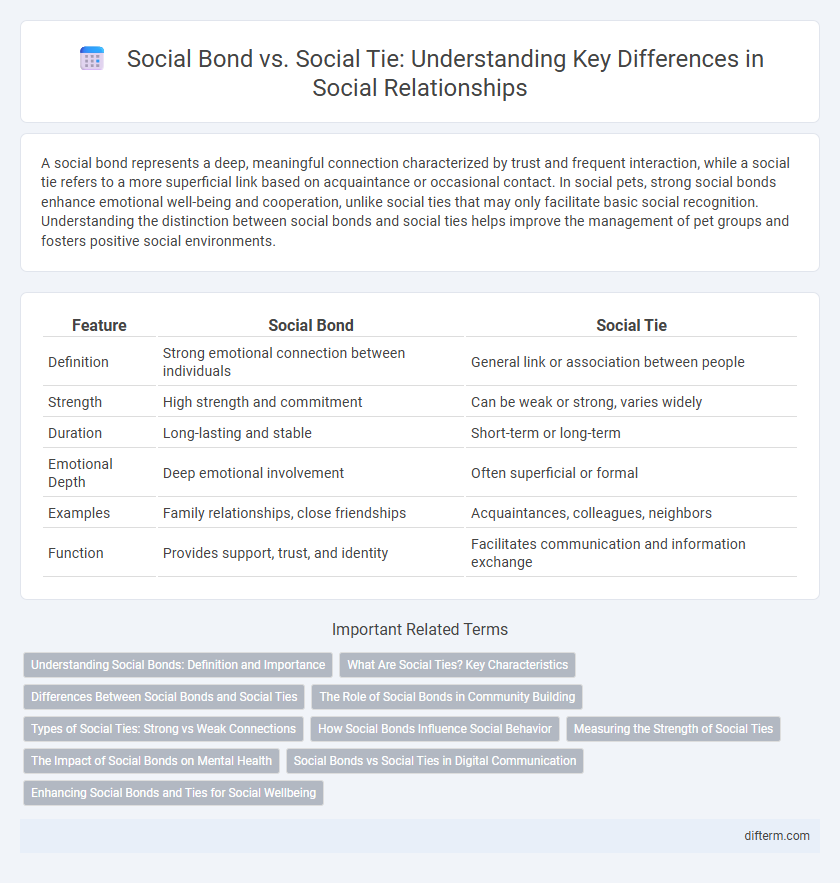A social bond represents a deep, meaningful connection characterized by trust and frequent interaction, while a social tie refers to a more superficial link based on acquaintance or occasional contact. In social pets, strong social bonds enhance emotional well-being and cooperation, unlike social ties that may only facilitate basic social recognition. Understanding the distinction between social bonds and social ties helps improve the management of pet groups and fosters positive social environments.
Table of Comparison
| Feature | Social Bond | Social Tie |
|---|---|---|
| Definition | Strong emotional connection between individuals | General link or association between people |
| Strength | High strength and commitment | Can be weak or strong, varies widely |
| Duration | Long-lasting and stable | Short-term or long-term |
| Emotional Depth | Deep emotional involvement | Often superficial or formal |
| Examples | Family relationships, close friendships | Acquaintances, colleagues, neighbors |
| Function | Provides support, trust, and identity | Facilitates communication and information exchange |
Understanding Social Bonds: Definition and Importance
Social bonds represent strong, enduring connections characterized by emotional depth, shared values, and mutual support, distinguishing them from more superficial social ties. These bonds foster trust, cooperation, and resilience within communities, playing a crucial role in individual well-being and collective social stability. Understanding social bonds aids policymakers and psychologists in enhancing social cohesion and addressing issues like isolation and social fragmentation.
What Are Social Ties? Key Characteristics
Social ties represent the direct connections between individuals, characterized by interactions and emotional bonds that influence behavior and social support. Key characteristics include frequency of contact, emotional intensity, and the type of relationship, such as kinship, friendship, or acquaintance. These ties form the foundation of social networks, impacting information flow and community cohesion.
Differences Between Social Bonds and Social Ties
Social bonds represent deep, enduring connections characterized by emotional attachment, trust, and mutual support, often found within family and close friendships. Social ties are broader and more superficial links, including acquaintances or professional contacts, primarily facilitating information flow and network expansion. Understanding these differences is crucial for analyzing social capital, community cohesion, and individual well-being within social networks.
The Role of Social Bonds in Community Building
Social bonds create deep emotional connections that foster trust and cooperation within communities, reinforcing a sense of belonging and mutual support. These bonds differ from social ties, which are often weaker, more superficial connections, lacking the strong relational commitment essential for sustained community building. Strengthening social bonds promotes collective identity and resilience, crucial for addressing communal challenges and enhancing social cohesion.
Types of Social Ties: Strong vs Weak Connections
Strong social ties, characterized by close-knit relationships such as family and close friends, provide emotional support and trust, reinforcing social bonds. Weak social ties, found in acquaintances or casual contacts, facilitate access to new information and opportunities through broader networks. Understanding the distinction between these types of social ties is essential for analyzing social cohesion and community dynamics.
How Social Bonds Influence Social Behavior
Social bonds, characterized by strong emotional connections and long-term commitments, profoundly shape social behavior by promoting trust, cooperation, and mutual support within communities. These deep attachments encourage consistent social interactions, reinforcing shared norms and collective identity, which in turn facilitate prosocial behaviors and conflict resolution. Unlike transient social ties, social bonds create a stable social environment that enhances individuals' well-being and resilience through sustained interpersonal engagement.
Measuring the Strength of Social Ties
Measuring the strength of social ties involves evaluating the frequency, intensity, and emotional depth of interactions between individuals within a network, reflecting the variability of connection durability. Social bonds are often characterized by stronger ties, which encompass trust, reciprocity, and shared experiences crucial for social cohesion and support systems. Quantitative metrics such as interaction frequency and qualitative assessments like emotional closeness provide comprehensive insights into the robustness of these social connections.
The Impact of Social Bonds on Mental Health
Social bonds, characterized by strong emotional connections and mutual support, significantly enhance mental health by reducing stress and promoting feelings of belonging and security. Unlike social ties, which may be more casual or superficial interactions, deep social bonds foster resilience against depression and anxiety through consistent social support and shared experiences. Research from the American Psychological Association highlights that individuals with robust social bonds exhibit lower cortisol levels and improved overall psychological well-being.
Social Bonds vs Social Ties in Digital Communication
Social bonds represent deep, emotional connections characterized by trust and mutual support, while social ties refer to broader, often weaker relationships maintained through interactions. In digital communication, social bonds are strengthened through consistent, meaningful exchanges that foster intimacy and loyalty. Social ties, conversely, facilitate access to diverse information and networks but typically lack the emotional depth found in strong social bonds.
Enhancing Social Bonds and Ties for Social Wellbeing
Enhancing social bonds and social ties strengthens emotional support networks essential for individual and community wellbeing. Strong social bonds foster trust and shared identity, while social ties expand access to diverse resources and opportunities. Together, these connections promote resilience, reduce stress, and improve overall mental health outcomes.
social bond vs social tie Infographic

 difterm.com
difterm.com